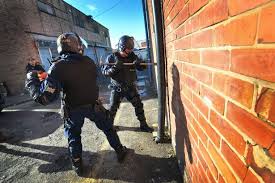Community Caretaking Searches
When Can You Enter?
Ron Martinelli, Ph.D.
Forensic Criminologist/Police Expert
Copyright © 10-27-2015
“Many of us do not know the names of our next door neighbors. Because of this, tasks that neighbors, friends, or relatives may have performed in the past now fall to the police.” (People v. Ray, 21 Cal.4th (1999))
It’s 0200 am hours on a hot August night. You are at an apartment fourplex on a loud noise complaint. As you walk up the stairs in an attempt to determine the location of the noise, you observe an open door. It’s completely quiet. As you illuminate the apartment’s interior with your flashlight, you note that nothing appears amiss and no one is stirring inside. No one responds to repeated knocks and announcements. The open door and circumstances seem suspicious and you believe that the occupant(s) might be in need of assistance. Can you enter?
The aforementioned are the “totality of circumstances” two Southern California police officers recently based their decision to enter a private residence where I recently offered expert opinion on during a civil trial alleging violations of civil rights under the 4th Amendment.
Few of the safeguards granted to individuals in the United States under our Bill of Rights are more vociferously defended than the 4th Amendment guaranteeing protection against unreasonable searches and seizures. This is especially the case where the entry of private residences are concerned.
Under the 4th Amendment, warrantless searches of private property are presumptively illegal. However, case law has created some exceptions to the warrant requirement. These exceptions are: (1) consent searches; (2) searches incident to custodial arrest; (3) probation/parole searches; (4) searches pursuant to “exigent circumstances;” and (5) community caretaking.
“Community caretaking” refers to an officer(s)’ reasonable belief that an occupant within a private premise is at imminent risk of harm; or there is some other serious emergency. If an officer reasonable believes a person inside an area that would be considered private property may be injured, ill, or a victim of a crime, and is in immediate need of assistance; the officer(s) may enter the property to render aid without a warrant.
As numerous United State Supreme Court and appellate cases consistently reflect, peace officers must demonstrate that probable cause exists to enter and search. Even though the Courts will consider the “totality of circumstances” to meet the 4th Amendment requirement, officers must have specific facts which can be articulated in court in a sworn statement (affidavit). Thus, probable cause requires something less than an absolute, or even a near certainty; but something more than a mere hunch, suspicion or an educated guess.
Probable cause to enter a premise to satisfy a reasonable belief that an occupant may be in need of immediate police/medical intervention may be based upon the “collective knowledge” of the officer(s) involved in an investigation; and all of the references which might be reasonable drawn from this information, with the officer(s)’ training and experience.
The Courts have ruled that because police officers possess unique education, training and experience; they are provided some level of investigatory latitude beyond that of a common citizen. This is because the Courts recognize that it is possible for an activity which otherwise appears innocent to the general public, can amount to probable cause to an officer.
However, it is important to remember that while an officer(s)’ training and experience may form the calculus for determining probable cause to enter; the ultimate facts must be seen and weighed as understood by a “reasonable officer.” Such determinations fall within the context of the “objective reasonableness” doctrine.
Examples of circumstances of a person being in imminent risk or harm and/or requiring immediate police/medical assistance include, but are not limited to: a person calling out for help, neighbors reporting hearing cries for help; groaning, crying, sounds of a person in distress; or a 9-1-1 dispatcher reporting similar information; officers observing blood or other evidence of possible injury or a person in medical distress; or similar specific circumstances, statements or facts.
Examples of circumstances which might allow officer(s) to reasonable believe that a crime is in-progress, or has recently occurred include, but are not limited to: a 9-1-1 dispatcher reporting that an occupant or neighbors report a crime in-progress at the location; objective signs of forced entry such as a forced door/window; room(s) and furniture in disarray; blood evidence, bullet holes; coupled with or separate from a person calling out in distress; or no one responding to an officer(s)’ knock and announcements.
Examples of other emergencies that would allow an officer(s)’ warrantless entry into private property include, but are not limited to: fire, gas leak, explosion, flood, earthquake, tornados, chemical spills; or other types of natural disasters that would pose a danger to persons and/or property.
Calculus of Objective Reasonableness to Enter
The Courts have provided police officers with three basic guidelines that provide a calculus for determining whether or not it is objectively reasonable for them to enter private property. These are:
(1) The reliability of information – Was the need for the warrantless entry and/or search based upon reliable information;
(2) Likelihood of occurrence – Did it appear that the threat was real; or was it merely “within the realm of possibilities;” and
(3) No basis for a warrant – Would the circumstances have satisfied the issuance of a warrant under normal circumstances.
Officers are reminded that an “emergency aid” entry is permitted only if two of the above requirements are met.
To summarize, the balancing test for officers to remember when forming any determination to enter private property absent of consent or a warrant is that their entry and/or search within the “community caretaking” exception will be allowed only if a reasonable officer experiencing similar circumstances “would have perceived a need to act in the proper discharge of his/her community caretaking functions.” (People v. Ray, 21 Cal.4th 464, 477 (1999))
About the Author
Ron Martinelli, Ph.D., CMI-V, BCFT, CFA, is a nationally renowned Forensic Criminologist, Federal/State qualified police practices expert and a Certified Medical Investigator who directs the nation’s only multidisciplinary Forensic Death Investigations & Independent Review Team. Visit his law enforcement/forensics social media site at http://www.DrRonMartinelli.com.
Special thanks to former U.S. Attorney and police practices legal expert Mark Jarmie, Esq. for his peer review of this article.
Legal References
People v. Ray (1999) 21 Cal.4th 464, 467, 472
U.S. v. Rodriquez-Morales (1st Cir. 1991) 929 F.2d 780, 784-5
People v. Ramey (1976) 16 Cal.3d 276, 276


[…] Community Caretaking Searches; When Can You Enter? […]
LikeLike